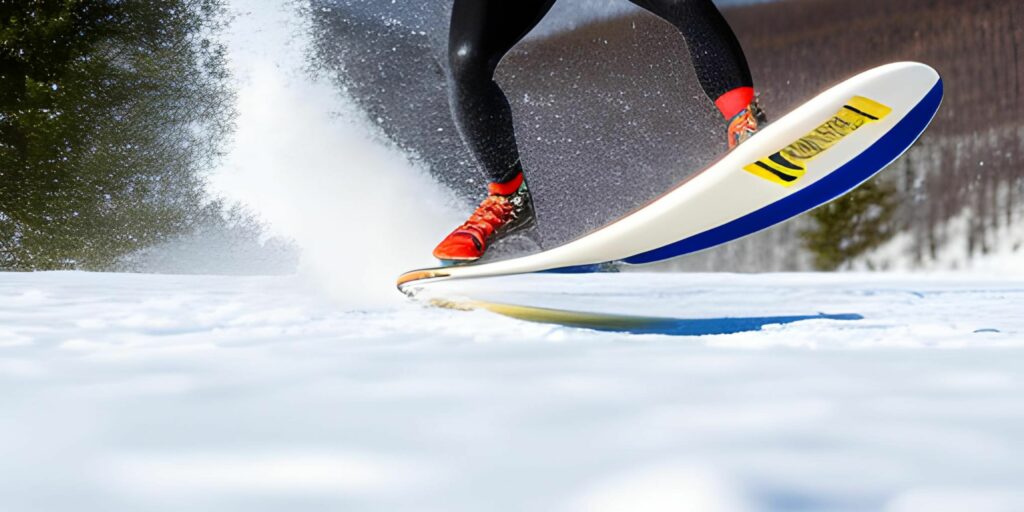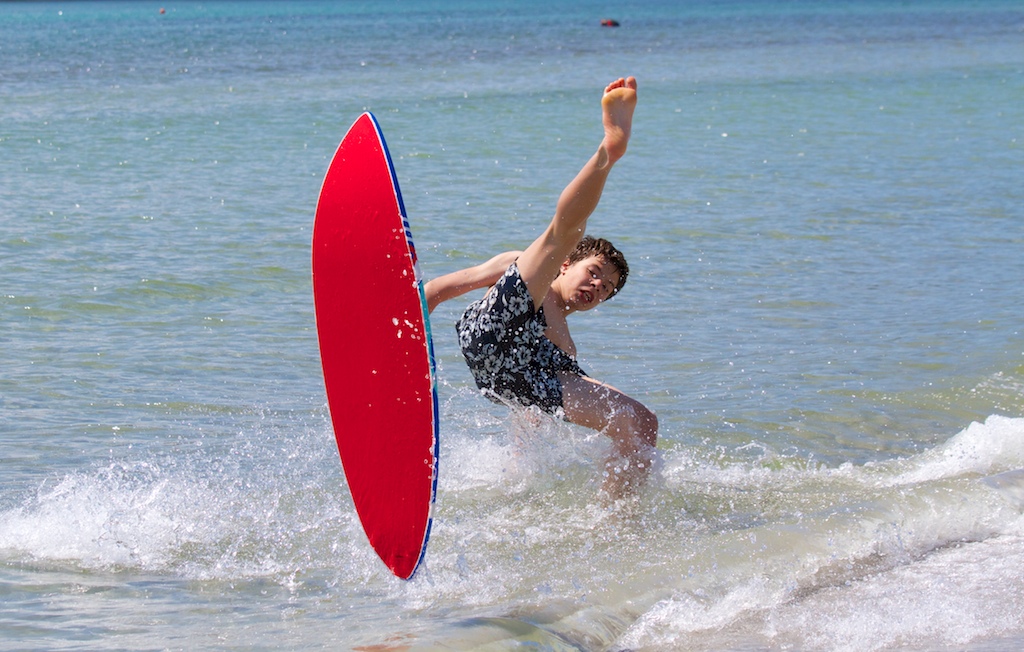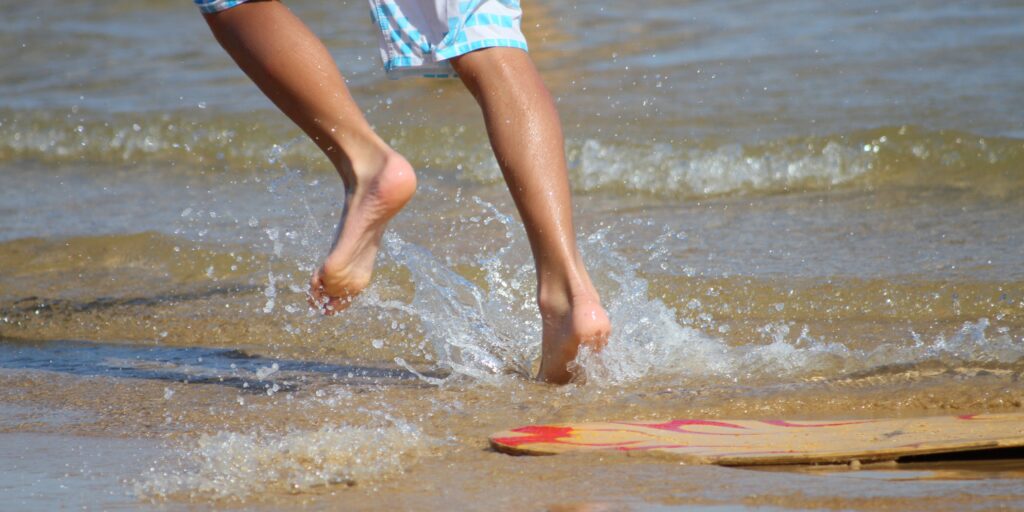Skimboarding is my passion, my escape from the daily grind. I love nothing more than feeling the rush of adrenaline as I glide across the water’s surface, carving out new paths with every twist and turn. But as winter approached, I found myself wondering: can you skimboard in the snow? As a dedicated skimboarder, I knew I had to find out.
So, I did some research and discovered that skimboarding in the snow is, in fact, possible! In recent years, this unique sport has been gaining popularity among winter sports enthusiasts. As someone who loves the thrill of trying new things and pushing my limits, I couldn’t resist the challenge. In this article, I’ve shared with you everything, I’ve learned about skimboarding on snow

My 4 points experience of Skimboarding in Snow
For those of us who love to skimboard, the thrill of gliding over the surface of the water is hard to beat. But as winter approaches and the temperatures drop, we begin to wonder: can we replicate that feeling on snow? The answer is yes! Skimboarding on snow is a growing trend that allows us to enjoy the sport year-round. However, there are some key differences between skimboarding on water versus snow that every skimmer should be aware of.
4. The first and most obvious difference is the surface. Water is fluid and constantly moving, whereas snow is solid and stable. This means that you’ll need a different type of board for snow skimboarding, one that is designed to glide smoothly over the snow without getting stuck or sinking in. Snow skimboards tend to be wider and shorter than traditional skimboards, with a flat bottom and sharp edges that provide better grip and control on the snow.
3 Another key difference between water and snow skimboarding is the speed. When skimboarding on water, you rely on the momentum of the wave to propel you forward. On snow, however, you’ll need to generate your own speed by pushing off with your feet or using gravity to your advantage. This means that it may take some time to get used to the different techniques required for snow skimboarding.
2. In addition, snow presents its own set of challenges that water does not. For example, icy or compacted snow can be slippery and difficult to maneuver on, while deep powder snow can slow you down and make it harder to stay balanced. Wind and weather conditions can also have a greater impact on snow skimboarding than on water skimboarding, so it’s important to be aware of the forecast.
1. Despite these differences, there are also many similarities between water and snow skimboarding. Both require balance, control, and quick reflexes, and both offer the thrill of gliding over a surface that seems to defy gravity. If you’re a seasoned skimboarder looking for a new challenge, or simply someone who loves the rush of trying something new, give snow skimboarding a try. With the right gear, technique, and mindset, you might just find that it’s even more exhilarating than traditional skimboarding on water.
Challenges faced while trying to skimboard in the snow
As someone who has spent countless hours perfecting my skimboarding technique on water, I can attest that skimboarding on snow presents its own unique set of challenges. Here are some of the biggest difficulties I’ve encountered while trying to skimboard in the snow:
- Surface Conditions: Snow conditions can vary widely depending on factors such as temperature, humidity, and recent weather patterns. Some types of snow, such as deep powder or icy crust, can be difficult to skim on, while other types may require different techniques or adjustments to your equipment.
- Terrain: Unlike water, snow has a lot of texture and features, including moguls, ridges, and bumps. These can make it harder to maintain balance and control as you skim across the surface. It’s important to keep your eyes up and anticipate changes in terrain so that you can adjust your technique accordingly.
- Speed: Generating speed on snow is generally more difficult than on water, since you don’t have the benefit of waves or currents to propel you forward. To compensate, you’ll need to use gravity, your body weight, and your equipment to generate momentum. This may take some practice to master.
- Equipment: Skimboards designed for water are not always suitable for snow skimboarding. You’ll need a board that is specifically designed for snow, with features like a flat bottom, sharp edges, and a wider profile to help you glide smoothly over the surface. You may also need to adjust your bindings, boots, and clothing to better suit snowy conditions.
- Weather: Wind, cold temperatures, and precipitation can all impact your ability to skimboard in the snow. It’s important to dress appropriately for the weather and to be aware of the forecast before heading out. Wind can also affect your balance and stability, so be prepared to adjust your technique accordingly.
Preparing for Skimboarding in the Snow
Skimboarding on the snow requires different equipment and preparation than skimboarding on water. As someone who has spent many winters testing out new gear and techniques for snow skimboarding, I’ve learned that proper preparation is key. Here are some tips for getting ready to hit the slopes:
I. Choosing the Right Skimboard
- Look for a board specifically designed for snow skimboarding, with a wider profile, flat bottom, and sharp edges.
- Consider the type of snow you’ll be skimboarding on when selecting your board, as deep powder and icy crust require different types of boards.
II. Necessary Clothing and Gear
- Dress in warm, waterproof layers, including a good quality base layer, insulating mid-layer, and waterproof outer layer.
- Wear waterproof gloves or mittens, a warm hat or helmet, and high-quality snow boots.
- Goggles or sunglasses can help protect your eyes from wind, sun, and snow glare.
III. Safety Precautions to Take
- Always wear a helmet to protect your head from falls or collisions.
- Avoid skimboarding alone, especially in remote areas or unfamiliar terrain.
- Know your limits and stay within them. Don’t attempt maneuvers or conditions that are beyond your skill level.
- Check weather and avalanche conditions before heading out, and be prepared to adjust your plans accordingly.
Don’t Make these Mistakes
- Dress appropriately with waterproof layers and high-quality gear.
- Use a snow skimboard designed for snow conditions.
- Avoid advanced techniques until you’ve mastered the basics.
- Be aware of obstacles and adjust your line accordingly.
- Follow safety precautions, including wearing a helmet and avoiding solo skimboarding.
By avoiding these common mistakes and prioritizing safety and comfort, you can maximize your enjoyment of this exciting winter sport. Remember to take it one step at a time, practice regularly, and have fun!
I am Fornillos Bogs, a seasoned professional surfer and accomplished skimboarder originally from Tanauan, Leyte, Philippines. With a remarkable background in both sports, I have carved my niche in the aquatic world. Currently, I reside in Quezon City, Philippines, known for my exceptional skills on the waves and impressive performances in skimboarding competitions. My journey from the serene shores of Tanauan to the bustling city of Quezon City serves as an inspiring testament to my dedication and passion for riding the waves.


